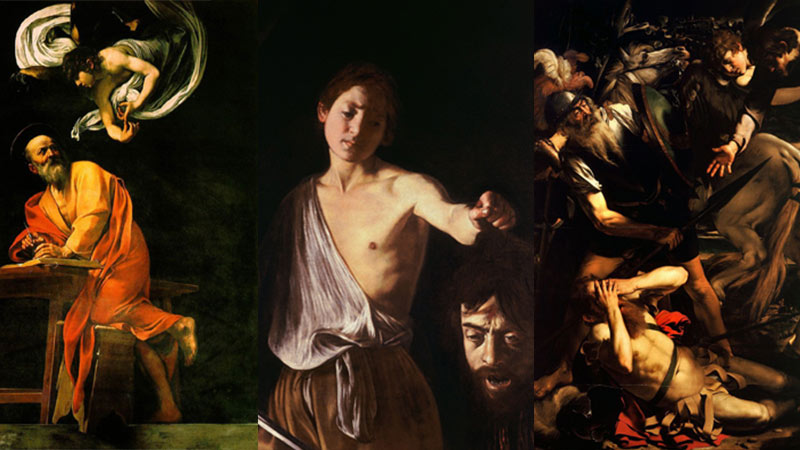
Caravaggio, the master of Baroque realism, transformed the art world with his revolutionary techniques and raw portrayal of human emotion.
His dramatic use of chiaroscuro contrasting light and shadow brings biblical and mythological scenes to life, capturing the viewer’s attention with striking immediacy.
Iconic works like “Judith and Holofernes” and “The Calling of Saint Matthew” exemplify his ability to blend the divine with gritty realism, making his art both shocking and captivating.
Despite a tumultuous life marked by scandal and exile, Caravaggio’s influence on Western art remains profound.
His departure from the idealized forms of the Renaissance paved the way for a more authentic representation of humanity.
In this exploration of 15 of his most famous paintings, readers will discover the masterpieces that not only showcase his artistic mastery but also reflect the complexities of his troubled existence.
1. The Calling of Saint Matthew
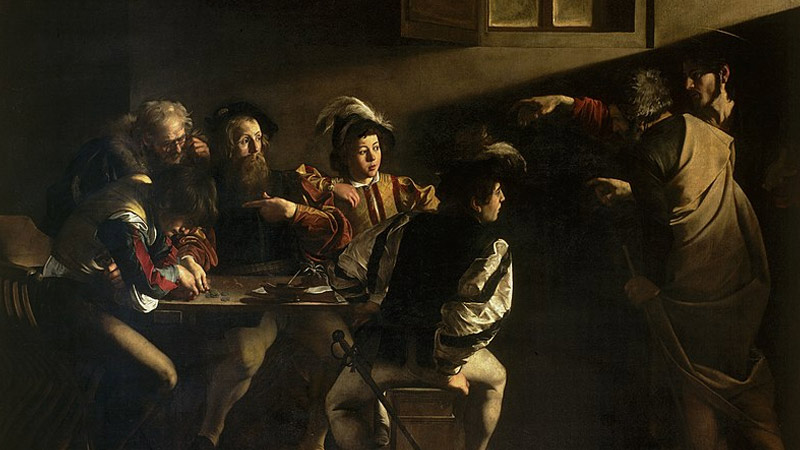
Caravaggio’s “The Calling of Saint Matthew,” completed between 1599 and 1600, is a striking visual narrative set in the Contarelli Chapel.
It masterfully illustrates the moment Jesus calls the tax collector Matthew to follow him. The painting features dramatic chiaroscuro, highlighting Matthew’s surprise and confusion as he points to himself, captured in a dimly lit, modest setting.
This artwork exemplifies Caravaggio’s groundbreaking approach by melding realism with emotional depth, cementing its status as a pivotal piece in Baroque art.
2. Judith Beheading Holofernes

Judith Beheading Holofernes, painted between 1598 and 1599, showcases Caravaggio’s dramatic flair.
It illustrates the biblical story of Judith, who seduces the Assyrian general Holofernes only to behead him.
The intense chiaroscuro highlights Judith’s determined expression and Holofernes’ shock, creating a striking visual impact.
This masterpiece resides in the Galleria Nazionale d’Arte Antica in Rome, further cementing Caravaggio’s influence in Baroque art.
3. The Taking of Christ
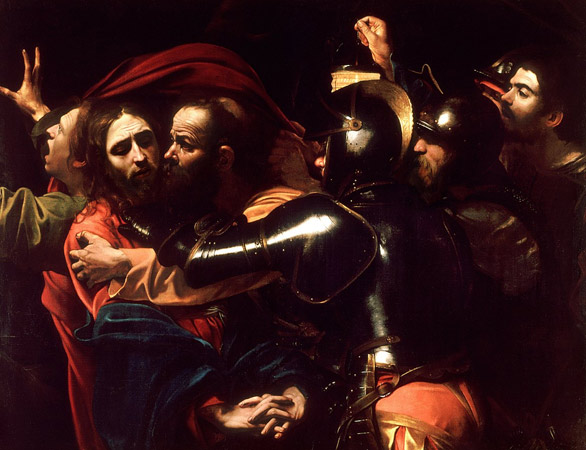
The Taking of Christ, painted around 1602, portrays the dramatic moment of Jesus’ betrayal by Judas. Caravaggio employs intense chiaroscuro, creating stark contrasts between light and shadow that heighten the emotional tension in the scene.
The figures, illuminated by a single source, express a range of emotions, from despair to betrayal. The painting captures the chaotic energy of the arrest, showcasing Caravaggio’s mastery in conveying human emotion and realism through his innovative techniques.
4. Basket of Fruit
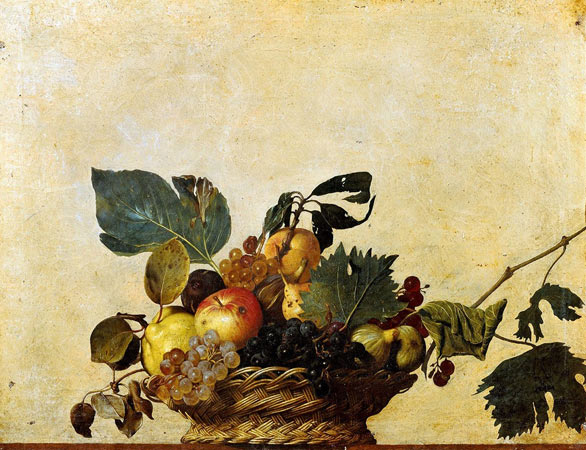
Caravaggio’s Basket of Fruit, painted between 1595 and 1600, is widely regarded as the first modern still life painting.
It depicts a wicker basket filled with fruits showing signs of decay, such as a few worm-eaten leaves and overripe grapes.
This piece, part of a significant transition in Caravaggio’s art, emphasizes his mastery of chiaroscuro and detailed realism.
It currently resides in the Ambrosian Library in Milan, attracting art enthusiasts and critics drawn to its unique portrayal of imperfection in beauty.
5. The Beheading of Saint John the Baptist

The Beheading of Saint John the Baptist, completed in 1608, stands out as Caravaggio’s only signed work, with his signature rendered in the blood of the saint.
This haunting scene depicts the moment of the martyrdom, emphasizing the stark emotional intensity through its dramatic contrasts of light and shadow.
The composition captures the viewer’s gaze with John’s helplessness, while the executioner’s violent act is portrayed with chilling realism, immortalizing both the brutality and the gravity of the moment. This masterpiece currently resides in St. John’s Co-Cathedral in Valletta, Malta.
6. Bacchus
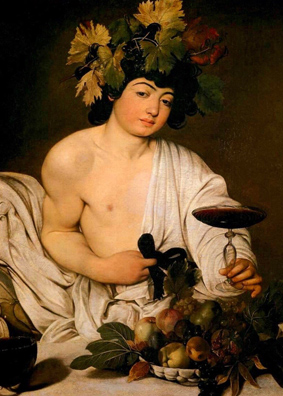
Bacchus, painted by Caravaggio around 1596, presents an unconventional portrayal of the Roman god of wine.
Depicted as a youthful yet unhealthy figure, Bacchus reclines languidly, inviting the viewer with a goblet of wine.
The underlying symbolism speaks to life’s fleeting pleasures, illustrated by the imperfect fruits scattered before him.
Using chiaroscuro, Caravaggio masterfully captures Bacchus’s alluring yet sinister nature, reflecting his own struggles with illness during the period of creation.
7. David with the Head of Goliath
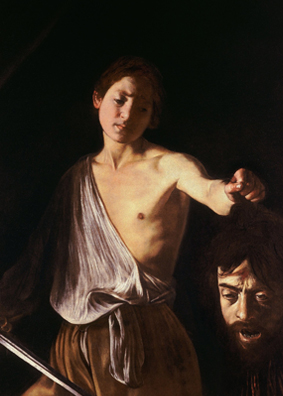
Caravaggio painted “David with the Head of Goliath” around 1606, showcasing a powerful moment of triumph. David, a bareheaded youth, holds Goliath’s severed head, which is a self-portrait of Caravaggio himself.
The painting’s heavy shadows create a feeling of isolation. David’s expression reflects discomfort, suggesting compassion for the fallen foe.
This dark depiction contrasts the usual celebratory theme, inviting viewers to explore the complexity of victory and mortality. The artwork currently resides in the Borghese Gallery in Rome.
8. Narcissus

Narcissus, painted between 1597 and 1599, captures the tragic tale of a young man enamored with his own reflection. Caravaggio portrays the handsome youth leaning over water, entranced by his distorted image.
The painting exudes melancholy, symbolizing the dangers of self-obsession. Currently housed in the Galleria Nazionale d’Arte Antica in Rome, this masterpiece showcases Caravaggio’s mastery of chiaroscuro, emphasizing the interplay of light and shadow in the scene.
9. Medusa
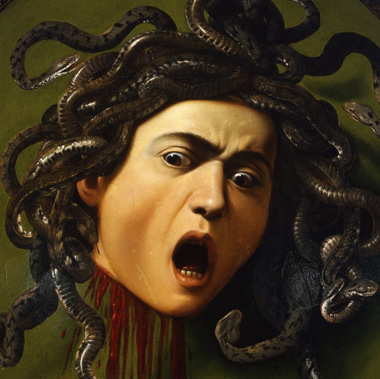
Caravaggio’s “Medusa,” created around 1597, features the severed head of the mythological monster, expertly depicted with striking detail.
The artwork, housed in the Uffizi Gallery in Florence, showcases Caravaggio’s mastery of chiaroscuro, as light plays dramatically on the bloodied surface.
Caravaggio’s unsettling self-portrait on Medusa’s face captures raw fear, diverting attention from his tumultuous life.
Commissioned by Cardinal Francesco Maria Del Monte, this painting symbolizes courage and serves as a ceremonial emblem for the Grand Duke of Tuscany.
10. Supper at Emmaus
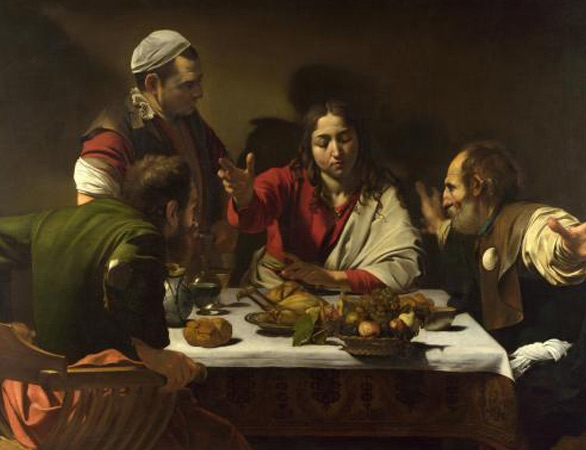
“Supper at Emmaus,” painted by Caravaggio in 1601, captures the dramatic moment when the resurrected Jesus reveals his identity to two disciples.
Jesus is depicted in bright light, while the disciples appear in shadow, emphasizing their disbelief. The inclusion of an innkeeper and a basket of imperfect fruit adds a sense of reality.
This original version resides in the National Gallery in London, showcasing Caravaggio’s innovative techniques and emotional depth.
11. Saint John the Baptist (Youth with a Ram)

Saint John the Baptist, painted around 1602, depicts a youthful and serene figure draped in humble clothing, holding a ram.
Caravaggio captures the essence of innocence blended with the weight of prophecy. The use of chiaroscuro emphasizes the striking contrast between light and shadow, highlighting the saint’s contemplative expression.
This masterpiece resides at the Nelson-Atkins Museum of Art in Kansas City, where it continues to captivate viewers with its emotional depth and masterful realism.
12. The Conversion of Saint Paul
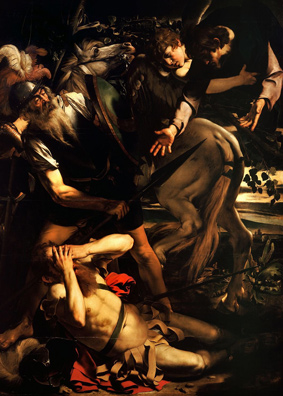
Caravaggio’s The Conversion of Saint Paul, created for the Cerasi Chapel, captures the moment St. Paul lies prostrate on the road to Damascus following a divine encounter with Jesus.
Caravaggio emphasizes St. Paul’s blindness with a brilliant play of light, directing the viewer’s gaze through masterful angles and body positioning.
The intense chiaroscuro highlights the overwhelming impact of the supernatural, showcasing Caravaggio’s ability to blend dramatic emotion with religious narrative.
13. The Crucifixion of Saint Peter
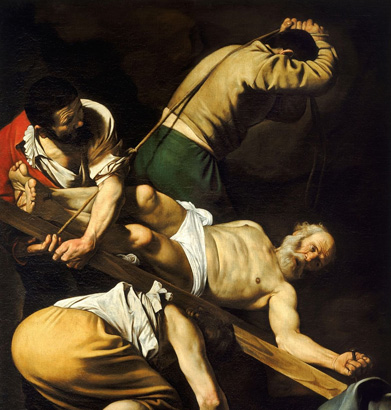
Caravaggio’s “The Crucifixion of Saint Peter,” completed in 1600, depicts the moment of Saint Peter’s martyrdom.
Caravaggio presents Peter being crucified upside down, illustrating his humility and unworthiness to die like Christ.
The dramatic chiaroscuro highlights the soldiers’ tension against Peter’s calm acceptance, capturing emotional depth.
Currently located in Santa Maria del Popolo, this powerful painting emphasizes the raw brutality of martyrdom and the profound sacrifice of the saint.
14. The Inspiration of Saint Matthew
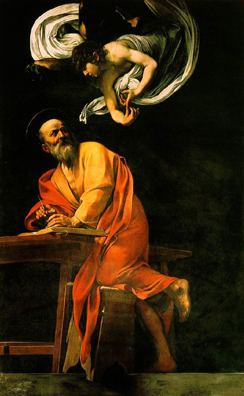
Caravaggio’s “The Inspiration of Saint Matthew,” completed in 1603, captures the moment when an angel guides Matthew to write his Gospel.
The mighty figure of the angel, draped in vibrant colors, contrasts with Matthew’s humble attire, emphasizing their different realms.
This painting showcases Caravaggio’s dramatic chiaroscuro, creating an ethereal light that draws focus to the divine message.
The composition exemplifies the spiritual transformation Matthew undergoes, reflecting Caravaggio’s command over emotive realism and religious storytelling.
15. The Martyrdom of Saint Matthew
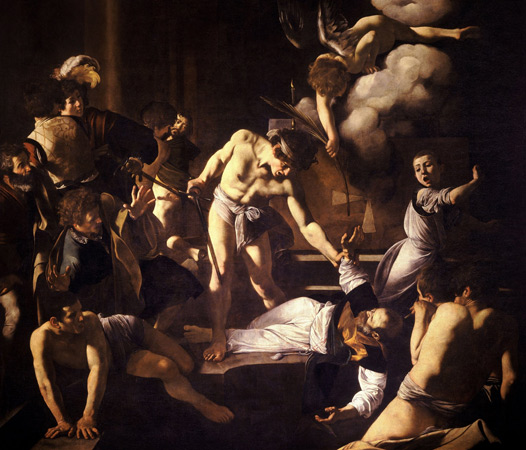
“The Martyrdom of Saint Matthew,” completed between 1599 and 1600, sits prominently in the Contarelli Chapel in Rome.
This powerful work portrays the dramatic moment of Saint Matthew’s execution, highlighting Caravaggio’s skill in chiaroscuro.
The scene captures intense emotional responses, from fear to reverence, as Matthew encounters his fate.
The composition, rich in symbolism, reflects the artist’s ability to convey the gravity of martyrdom through striking realism and dynamic contrasts of light and dark.






